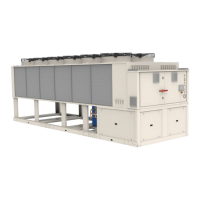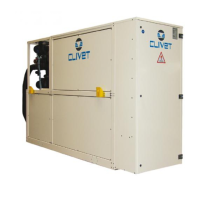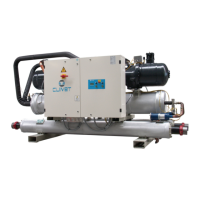
Do you have a question about the CLIVET WiSAN-YSE1 22.2 and is the answer not in the manual?
Adherence to safety regulations and use of personal protective equipment.
Understanding and mitigating potential risks during unit operation.
Procedures for handling unit breakdown or malfunction, including using original spares.
Details on refrigerant type (R32), safety class (A2L), and Global Warming Potential (GWP).
General principles for site selection, including regulations and environmental factors.
Maintaining clear airflow around coils for efficient heat exchange.
Importance of water quality and using treatment systems if parameters are outside limits.
Specifications for power supply, including voltage, frequency, and network compatibility.
Guidelines for laying and connecting signal/data lines, including cable type and grounding.
Steps for connecting the unit, including diagram reference, isolation, and earthing.
Checks for the refrigeration circuit: oil stains, pressure, and service outlet closure.
Electrical checks: ground connection, conductor tightness, voltage, frequency, and phase balance.
List of alarm codes, error descriptions, and unit protection conditions.
Details on temperature sensor fault detection and reset procedures.
Performing safety checks to minimize combustion risk when working with refrigerants.
Using detectors to ensure the absence of flammable refrigerants and using safe equipment.
Strict prohibition of ignition sources in proximity to refrigerant systems.
Initial safety checks on electrical components and ensuring safety before operation.
Acceptable methods for detecting flammable refrigerant leaks, emphasizing electric detectors.
Procedure for safe removal and evacuation of refrigerant, including purging and vacuuming.
Safe procedures for dismantling equipment and recovering refrigerants.
Best practices for safe refrigerant recovery during service or decommissioning.
Safety precautions for maintenance operations, including PPE and reading warnings.
Maintenance performed by authorized personnel to ensure efficiency and lifespan.
Scheduled maintenance checks and their recommended frequencies for optimal performance.
Safety warnings and procedures for disconnecting the unit, including refrigerant recovery.
Identification of common risks not controllable by the manufacturer.
Risks associated with electric connections, components, and earthing system.
Risks associated with refrigerant exposure, intoxication, and contact with heat sources.
Technical details for Modbus communication: protocol, speed, data bits, parity, and stop bit.











